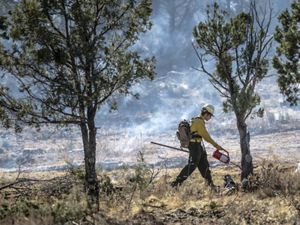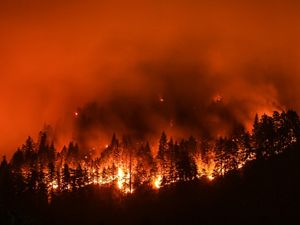How the West Fights Fire with Fire
Discover TNC’s multifaceted approach to restoring dry forests.
The Problem: In the West, wildfire touches everyone. While fire can be a powerful regenerative force for nature, megafires and other severe wildfires burn millions of acres per year, threatening our air and water, devastating wildlife habitat and causing billions of dollars of damage. This crisis is particularly acute in Western dry forests. After a century of suppressing fires and excluding traditional Indigenous management, many of these landscapes are dangerously overgrown. Coupled with climate change, which has resulted in unprecedented warm and dry conditions, fires that historically rejuvenated these forests can now explode into destructive blazes that scorch soils, prevent regrowth and threaten lives.
Urgent action is needed. That’s why TNC is employing a wide range of practices—including prescribed burns and strategic thinning—to keep Western dry forests healthy.

TNC’s Plan: We’re working to increase resilience across Western dry forests by conducting ecological forest restoration, including the use of prescribed fire, in partnership with Tribes, local communities and agencies like the USDA Forest Service.
These forests evolved with frequent cycles of fire. At the right frequency and intensity, fire recycles critical nutrients in soil and stimulates new forest growth.
The use of proactive, prescribed burns for forest management goes hand-in-hand with strategic thinning, reforestation, enhancing soil health, protecting watersheds and a wide range of other practices that support healthy forests. TNC recognizes that there are many types of forests in the Western United States, each with its own characteristics, and there is not a “one-size-fits-all” solution. That’s why ecological forest restoration must be carefully tailored to each situation.
Prescribed fire is one form of fire that provides benefits to people and nature. The cultural burning practices of Indigenous Peoples, who for millennia have tended the forests of the West with fire, are another form of beneficial fire—one that has contributed greatly to the fire-adapted evolution of Western dry forests. Recognized by science and traditional knowledge, it’s time to elevate beneficial fire, along with its cultural and natural values, and accelerate the safe use of cultural burning and prescribed burning
It’s time to bring forests back to health and reduce the impacts of extreme wildfire events on our natural areas and communities.
What is Ecological Forest Restoration?
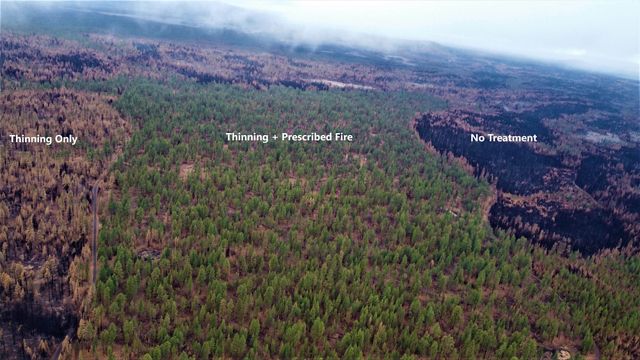
Ecological Forest Restoration in Action: Aerial photography shows how different treatments moderated the impact of Oregon’s 2021 Bootleg Wildfire.
Ecological forest restoration is a proven technique for keeping Western dry forests healthy and preparing them to withstand severe fires and other threats exacerbated by climate change. It often includes a combination of strategic thinning, meaning the removal of brush and small or unhealthy trees to reduce fuel loads, and the application of beneficial fire as a follow-up or maintenance treatment. Ecological forest restoration may also consist of beneficial fire on its own, without other treatments, if conditions are right.
State by State
Across the West, TNC is advancing ecological forest restoration through a wide range of projects, partnerships and initiatives. Take a tour of the many different approaches that are currently underway.








Western States Fire Map TNC is working hard to break the cycle of disastrous megafires in the Western United States. We use on-the-ground science, education and advocacy to make a difference in the geographies that need us most. See what we are doing in each of the western states.

Future Forests
Arizona
TNC operates much like a learning laboratory and tests various efficiencies, with the intent of saving money and time for the forest industry that is involved with restoration.
Case in point…Arizona is streamlining forestry work with technology. The labor-intensive process of painting trees to indicate which should be cut or left to grow is replaced with a GPS marking capability on a tablet. The tablet is then loaded into the harvester to guide which trees need to be cut to make the forest healthier. These technologies result in significant cost and time savings benefits, creating opportunities for more restoration projects.
Additionally, adjustments to long standing business practices can substantially impact costs and time to implement ecological thinning, with examples including the U.S. Forest Service waiving truck weigh-ins and marking and branding of all logs on TNC projects. What that means is that trucks do NOT need to stop to be weighed and every log does not need to be marked as it leaves the forest. This saves an incredible amount of time. Our intent is to expand this across the region and other areas of the country where low to no value wood is being removed during forest restoration.
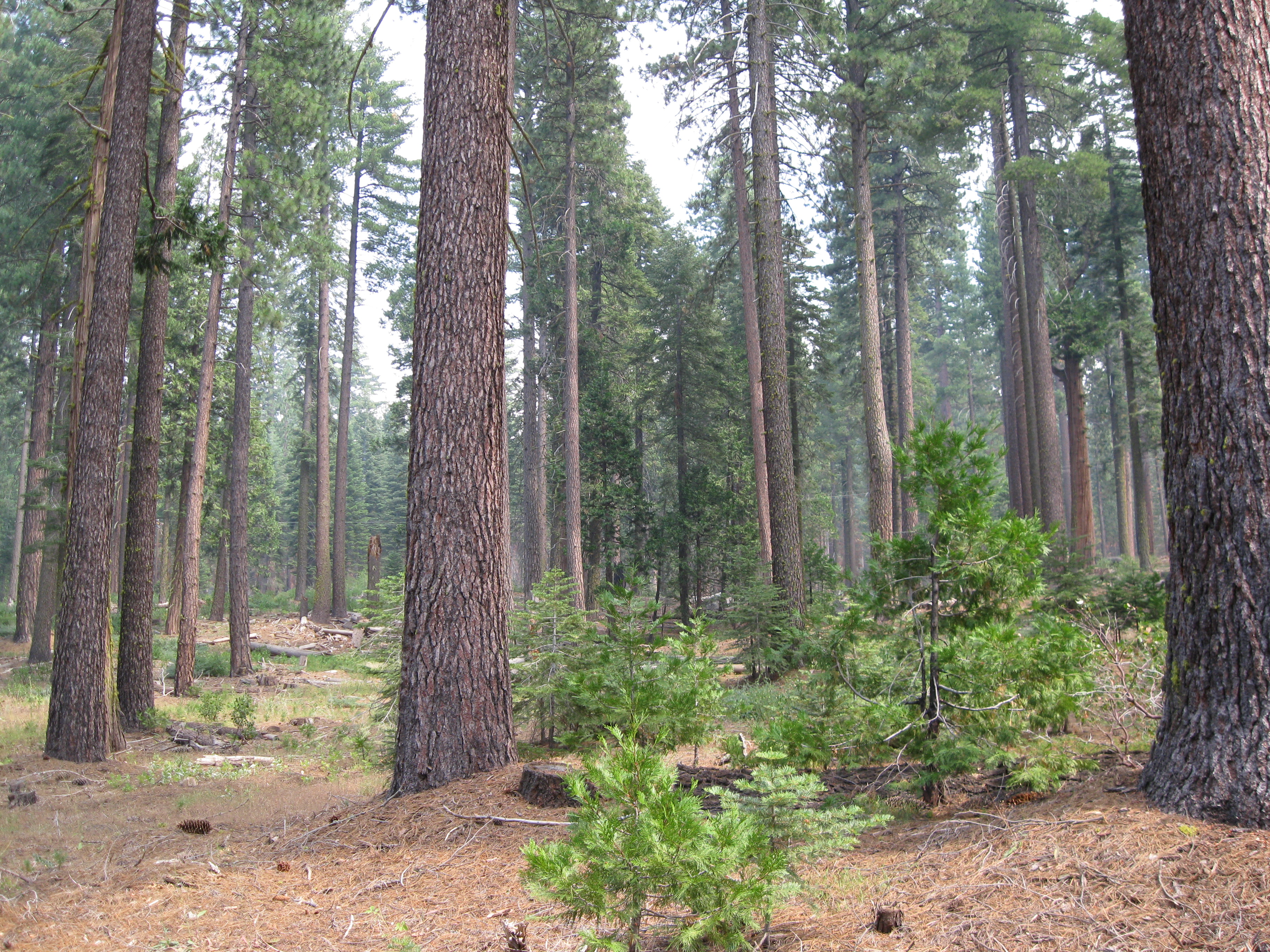
Growing our Impact
California
The Nature Conservancy in California has a plan to save the Sierra Nevada from catastrophic megafires by exponentially increasing the amount of forest we restore. Here’s how we get there.
2,300 ACRES: INDEPENDENCE LAKE PRESERVE - Project Complete
After establishing the preserve in 2010, we launched our first forest restoration efforts on these lands with ecological thinning and prescribed burning.
28,000 ACRES: FRENCH MEADOWS/AMERICAN RIVER HEADWATERS - PROJECT IN FINAL PHASE
TNC brought together state, federal and local partners for this first-of-its-kind collaboration, which is 10-times larger than our Independence Lake Project.
275,000 ACRES: NORTH YUBA RIVER WATERSHED - Planning Phase Complete
This project will be the largest forest restoration of its kind in the Sierra. We are working with nine partners to restore one of the most critical watersheds in the region.
2.4 MILLION ACRES: TAHOE-CENTRAL SIERRA INITIATIVE - Science Effort Complete
TNC was invited to work with the U.S. Forest Service to lead the science effort that will guide restoration across the 2.4 million-acre band of forest surrounding Lake Tahoe.
Quote: Sarah Heard
Ecological forestry protects homes and businesses and it can significantly reduce insurance premiums. When insurance savings from ecological forestry are used to finance forest restoration, a vicious cycle becomes a virtuous one.

Reforesting After Wildfires on Colorado’s Front Range
Colorado
Wildfires in the Western United States, an important source of natural disturbance, have increased in size, frequency and severity in the last 30 years. Forest recovery following these fires has been limited, particularly in ponderosa pine forests which characterize much of Colorado’s Front Range. These fires leave larger patches of forests without trees and without the seed sources they need to regenerate.
We can set Colorado’s burn scars on a new trajectory toward resilience and recovery by ramping up reforestation and investing in science and cutting-edge innovation.
TNC is working on new technologies to directly seed burned areas to increase the pace and scope of reforestation.
Direct seeding can reach areas that are more difficult to access including steep slopes and areas farther from roads.
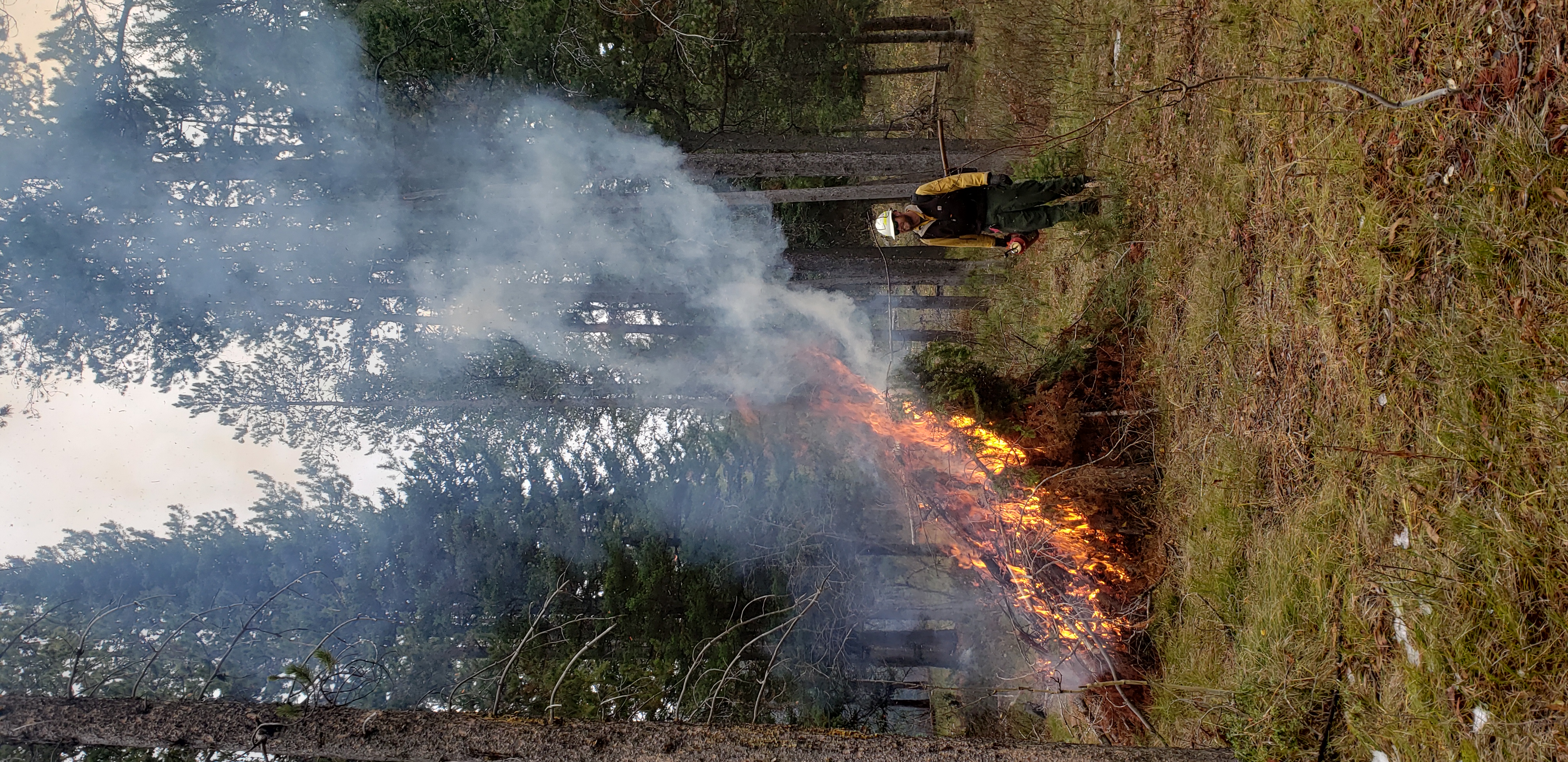
Mobilizing Prescribed Fire Crews to Any Idaho National Forest
Idaho
Since 2021, TNC has been developing partnerships with national forests across Idaho to hire, train and deploy fire professionals with one goal in mind: to get more prescribed fire in our forests and restore forest health. Our partnerships with the Boise, Payette, Caribou-Targhee and Idaho Panhandle National Forests proved so successful that in 2023, TNC signed a statewide agreement with the U.S. Forest Service to expand our mobilization of prescribed fire crews to any national forest within Idaho.
TNC’s fire crews are focused on proactive treatments and help the U.S. Forest Service tackle a backlog of prescribed burning and thinning projects. This model of increased workforce capacity helps address the problem at scale and expands much-needed solutions across Idaho forests.
Quote: Matthew Ward
Recognizing the vital role of prescribed fire to restore forests—and the great need for more workforce capacity to accomplish it—TNC has spent years developing strong partnerships with national forests’ staff in Idaho.

Restoring Forests–and Indigenous Rights–with Fire
Montana
In the dry forests of western Montana, TNC staff are conducting controlled burns alongside fire crews from the Confederated Salish and Kootenai Tribes. The effort, in partnership with the Bureau of Land Management, is part of the Reserve Treaty Rights Lands program. This is a recommitment by the U.S. government to honor nation-to-nation treaties between the United States and Tribal Nations that commit the U.S. to keep forests healthy so Native peoples can hunt, harvest plants and use the lands in other culturally important ways.
Through the program, the Confederated Salish and Kootenai Tribes have committed staff and money they received from the Bureau of Indian Affairs to help the U.S. Bureau of Land Management conduct controlled burns. The crews also thin forests using chainsaws. TNC has joined in the effort, deploying our staff and contractors to restore forests on both federal lands and lands we manage. “This partnership helps us continuing the pattern of burning that the Indigenous Peoples who call this place home have been doing for thousands of years,” explains Mike Schaedel, Forest Restoration & Partnership Manager for TNC in Montana. “It’s an honor to be part of that, and to know we’re improving critical habitat for wildlife and protecting the homes of people.”

Truckee River Watershed
Nevada
The Nevada Chapter is a member of the Middle Truckee River Watershed Partnership, and together we are advancing forest health and fuels reduction projects. Our partners include Truckee Meadows Water Authority, Truckee River Watershed Council, National Forest Foundation, Tahoe National Forest and others. In 2023, the partnership was awarded more than $10 million in funding from the California Wildlife Conservation Board to put toward the forest health work.
The Truckee River watershed supports threatened and endangered species and provides approximately 85% of the water supply for more than 400,000 people and 7,000 businesses in Reno-Sparks, Nevada. The river flows through the traditional lands of the Washoe Tribe of California and Nevada and terminates on the lands of the Pyramid Lake Paiute Tribe. Using our combined skills and assets, the partnership will develop and implement projects to reduce the risk of catastrophic wildfires and their impacts to water and other resources.
Learn more at truckeeforests.org

Protecting Water with Fire
New Mexico
In 2011, the Los Conchas Fire burned 156,000 acres in the Jemez Mountains and disrupted water delivery to Albuquerque for 40 days. TNC and partners launched the Rio Grande Water Fund in 2014, a collaborative large-scale effort designed to restore 600,000 acres of at-risk forests from southwest Colorado to Albuquerque.
The Rio Grande Water Fund has supported hundreds of thousands of acres of forest resilience projects, either directly or indirectly through our partners, using such tools as mechanical thinning and beneficial fire. The benefits include reduced wildfire risk, source-water protection for one million people, safer communities, economic growth, enhanced recreational opportunities and enhanced wildlife habitat. Forest restoration has been proven to change wildfire behavior, making them less destructive ecologically and for nearby communities and wildland firefighters working to manage them.

A Living Laboratory of Forest and Fire Research
Oregon
The Sycan Marsh Preserve—a living laboratory of forest and fire research—became a focal point during the 2021 Bootleg Fire, which burned so hot at times that it created its own weather. However, when the fire hit forested areas on Oregon’s Sycan Marsh Preserve that had previously been treated with a combination of ecological thinning and controlled burning, fire behavior changed significantly, dropping the flames from the treetops to the ground, greatly reducing the intensity, ecological damage and risk to firefighters.
The preserve, a 33,000-acre landscape of dry forest and high-elevation marsh, is home to the Jim Castles Applied Research Center. It is the heart of a national effort to study fire behavior, increase biodiversity and improve the safety of wildland firefighters, people and communities.
For years, TNC has been working with Indigenous Peoples, forest ecologists, fire practitioners and scientists to design and implement ecologically based forest restoration, study fire behavior and collect data on everything from air quality to the ways in which climate change affects forest resilience.
Quote: Don Gentry
When I think about the future, it's learning from [the Bootleg Fire] and it's trying to figure out how to move forward in a good way, but still keep important values there to guide us.

TNC Prescribed Fire Workforce Supports Utah
Utah
Utah has more than 18 million acres of forest across the state. Increased development and warmer, drier weather threaten our forests which filter and store water supplies. In partnership with the U.S. Forest Service, TNC in Utah will deploy prescribed fire crew members to support beneficial burns across the state when weather is optimal for this proactive strategy. The first beneficial burn happened in the Dixie National Forest in February and March of 2024. Fire practitioners burned wood piles across 132 acres near the community of Pine Valley. Additionally, the collaboration enabled training opportunities for some crew members.

Setting the Stage for Restoring Washington’s Forests
Washington
Over the past 10 years, TNC in Washington has been working on an innovative forest restoration project on Cle Elum Ridge, part of the nearly 38,000 acres of Central Cascades Forest land managed by TNC in Washington. Our goal is to conserve wildlife habitat, restore watersheds and increase community resilience.
Together with our partners, we’re using prescribed fire to make the forest healthier and improve the safety of the nearby communities while reducing the fuels that would cause large wildfires. In 2021, during the Cascadia Prescribed Fire Training Exchange, TNC and partners conducted our first-ever controlled burn on TNC-managed land on Cle Elum Ridge. We have burned 250 acres since and have more planned.
Using TNC science, the state Department of Natural Resources has estimated that 2.7 million acres need restoration in Eastern Washington. Our work on Cle Elum Ridge is showing what’s possible for other priority landscapes in Washington state and demonstrates how communities can be at the center of the solutions to fire management.
Quote: Hillary Lundgren
A community is never done with fire adaptation. Rather than starting at square one, communities can adapt each other’s work across different political, social and geographic contexts.
Bringing Beneficial Fire Back to Wyoming
Wyoming
Although forests cover a relatively small portion of Wyoming, they are vitally important to the state’s well-being. Most of Wyoming’s water begins as snowpack in the cool shade of those trees. Forests provide clean air, critical habitat for wildlife and some of the most beautiful landscapes that the state has to offer while also supporting the local economies and an outdoor way of life. But Wyoming’s forests are increasingly at risk due to climate change and warmer, drier weather. One solution to help our ailing forests? Fire.
The Nature Conservancy in Wyoming is working with scientists, natural resource management agencies, the private sector, local communities and other important partners to accelerate forest restoration and return beneficial fire to the landscape to maintain and restore ecosystem health.
Along with the Bridger Teton National Forest, TNC is deploying a prescribed fire crew that will work to prepare project areas for prescribed fire as well as implement fire when conditions are appropriate in the Greater Yellowstone Ecosystem. The module is hired, trained and managed by TNC and paid for through federal funds provided by the Inflation Reduction Act. This collaborative effort will help reduce fuels across forested areas, improve community safety, restore ecosystem health and build social resilience in a changing climate.
Frequently Asked Questions
-
No. Ecological forest restoration in Western dry forests is generally designed to remove only the smaller trees that have grown in the absence of frequent fire while protecting the older, more established trees. This process often begins with “ecological thinning,” the strategic removal of smaller or unhealthy trees that can bring fire up into the forest canopy where it can more easily and quickly spread to surrounding trees and become a severe wildfire. Ecological forest restoration may also consist of using beneficial fire, on its own, to reduce vegetation and woody debris on the forest floor. While ecological forest restoration may involve the sale of forest products, it is driven by the ecological management needs of the forest rather than an emphasis on profit.
FACT: Ecological forest restoration improves the way the forest functions. The trees that are removed through strategic thinning are selected based on extensive science and field observation, with the goal of making sure that the surrounding trees are better able to survive a severe wildfire. Thinning reduces competition for limited soil moisture, which increases tree growth and strengthens a tree’s defense system to insect outbreak and drought.
**BONUS FACT: Smaller thinned trees and other woody debris removed during the restoration process can be burned in a special furnace to produce biochar—a supplement that helps soils hold more water. In Montana, TNC is conducting a pilot project to test whether biochar can create a new economic market for materials removed from thinning.
-
No. Fire that occurs at the right place and right time can be very beneficial to forest health and help accomplish outcomes important to nature and people, including reducing wildfire risk and protecting watersheds and wildlife habitat. Smokey Bear told us that it was our job to and while preventing or suppressing unwanted fires is a good idea, eliminating the natural role of fire in many forests is not. Shifting climate conditions and decades of fire exclusion have increased the size and frequency of extreme wildfires across the United States, bringing greater levels of risk to human communities and natural systems. Beneficial fire, including prescribed burns, can help restore forests to a more resilient condition able to better withstand wildfire.
FACT: Western dry forests evolved with frequent fire. Low-severity fire is critical to sustaining forest health in dry, lower elevation forests and can help fire workers better reduce the risk of severe fires. Indigenous Peoples tended Western forests using intentional fires and lived productively with fires caused by lightning strikes and other natural phenomena for millennia. Now, it’s time to elevate the value of these practices and expand the safe use of fire by Indigenous and non-Indigenous practitioners.
-
Great efforts are taken to ensure the safety of prescribed fire. They are a form of beneficial fire through which experienced fire practitioners carefully plan, implement and monitor the safe and effective use of fire to achieve management objectives. It’s important to note that fire is inherently dangerous and there is always an element of risk. Burns are staged by trained fire practitioners who ensure that the timing, weather conditions and moisture levels are right to keep fire from spreading beyond designated boundaries. Practitioners use best practices and extensive planning to prevent accidents.
FACT: Prescribed burns help reduce the impacts of extreme wildfires. Forests where ecological forest management, including prescribed burns, has been completed are healthier, more resilient to climate change and less vulnerable to destructive wildfires. Check out Science Leads the Way for recent studies and more information.
-
Prescribed burns are managed by trained, experienced fire practitioners who evaluate all the necessary factors—weather, moisture levels, humidity, wind and more—to ensure conditions are exactly right for a safe and controlled burn. Managing for the potential impacts of smoke is a key factor in this. Because the timing is carefully planned, there is greater opportunity to manage where smoke goes and to work with local communities to minimize disruption.
Smoke from prescribed burning is regulated in many states, and TNC complies with all local regulations. When impacts can’t be avoided, fire practitioners might call or visit smoke-sensitive individuals in advance to discuss ways they might avoid or minimize smoke exposure.
FACT: Wildfires, on the other hand, can burn unpredictably for weeks or months on end, threatening homes and infrastructures and blanketing entire regions with smoke. Smoke from wildfires can be particularly toxic because it contains particles from buildings and cars, which smoke from prescribed burns does not.
In a statement from the American Lung Association: “Prescribed fire is a key fire management strategy that provides ecosystem benefits and can be used to mitigate the negative air quality, health and safety impacts of large-scale wildfires.”
-
Wildlife may be briefly displaced during a prescribed burn but the habitat they depend on is often improved as a result of the burn itself. Prescribed burns are frequently used, in part, to improve wildlife habitat and some species are seen returning to managed sites right away. An unnaturally high severity wildfire, on the other hand, can destroy the forest habitat on which species depend, causing them to be displaced from the area for a long period of time or sometimes permanently.
-
When we use these restoration tools effectively, our forests and the communities around them are less likely to experience megafires, defined as a fire that burns more than 100,000 acres. With proactive treatment, communities are better protected from severe wildfires. At the same time, forests become more resilient and better able to withstand climate change.
Fact: The Fire Adapted Communities Learning Network provides community-based leaders with resources, tools and connections to reduce their wildfire risk and increase community preparedness. The network focuses on relationships each community has with their surrounding landscape. It is a catalyst for spreading fire adaptation practices and innovations nationwide.
-
People power, political will and deep-seated fears around fire make it harder for us to take advantage of beneficial fire. In order to increase the use of prescribed burns, we need more practitioners, more training and new laws and liability protections. We also need to strengthen collaborative, community-based efforts to bolster natural systems’ resilience and support fire-adapted cultures. These ideas are foundational to why and how TNC works with fire.
Fact: TNC and partners lead Prescribed Fire Training Exchanges, known as TREX. Each year, TREX and Women-in-Fire TREX events bring together hundreds of fire practitioners across the nation to share skills and engage in practical lessons on how to use fire both safely and effectively. Since 2008, more than 150 TREX events countries including the United States, Canada, Portugal, South Africa and Spain have provided training and hands-on experience to about 4,300 people. In recent years, more than 30% of TREX and other cooperative burning event participants have been women. The program hopes to help build the national prescribed fire workforce to 15,000 people, equivalent to the full-time fire staff of the federal agencies.
-
As forests grow—including when they regenerate after wildfires—they naturally store carbon in a process called sequestration. Forests also emit carbon through processes like decay and decomposition, which are natural parts of a balanced carbon cycle. However, disturbances like fire, drought and insects also lead to carbon emissions, and some scientific studies suggest that climate change is increasing the frequency and intensity of these events. The result is that the carbon cycle is getting imbalanced, with forests emitting far more carbon than they are sequestering.
Luckily, there are some studies which find that by reducing extreme wildfires and increasing or sustaining growth and recovery after wildfires, we can restore balance to the carbon cycle in dry forests.
Our Experts in Action
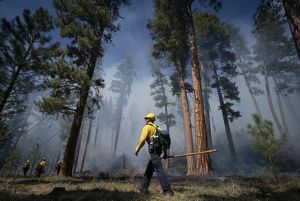
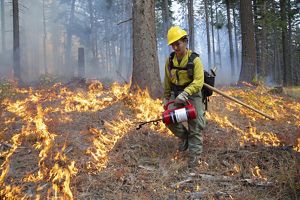
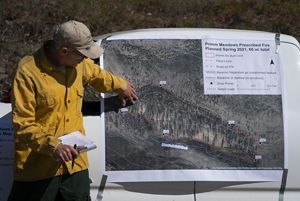
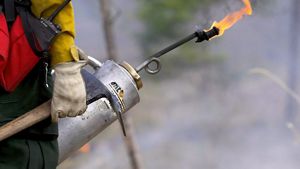

Primm Burn: TNC and its partners including the Montana Department of Natural Resources and Conservation are conducting the burns throughout the valley including Primm Meadow. © Jeremy Roberts | Conservation Media LLC

Washington: A prescribed fire practitioner during the 2021 Cascadia Prescribed Fire Training Exchange (TREX) near the town of Roslyn, Wash. © John Marshall

Primm Burn: Crown of the Continent Director and burn boss Dave Hanna conducting critical briefing on the fire plan. Primm Meadow controlled burn in MT. © Jeremy Roberts | Conservation Media LLC

Drip Torch: Used to control precisely where fire is put on the ground, a drip torch is an important tool used during a planned fire. © Jeremy Roberts
Science Leads the Way
TNC has worked with leading experts from multiple universities and the U.S. Forest Service to complete an extensive body of research that demonstrates how ecological restoration can reduce the vulnerability of Western dry forests to wildfires. From studies that show how ecological forest restoration reduces the severity of wildfires to those examining the intersections of forest and fire management with human health, we’ve assembled some of the top resources that guide TNC’s approach. Please use this library to take a deeper dive into:
-
With collaborators at the U.S. Forest Service, TNC recently published the most comprehensive study to date that found overwhelming evidence that ecological forest restoration reduces the severity of subsequent wildfires. Wildfire severity on sites that received prescribed fire or a combination of prescribed fire and mechanical thinning was 60% lower than nearby areas that were not treated.
Read the study: Davis et al. (2024) Tamm review: A meta-analysis of thinning, prescribed fire and wildfire effects on subsequent wildfire severity in conifer dominated forests of the Western US. Forest Ecology and Management
-
As the climate and wildfire crises have intensified, so too have concerns regarding the loss of carbon captured and stored in forests from decades to centuries of tree growth. Research published in Environmental Research Letters highlights widespread “opportunity hot spots” in the western United States where using proactive forest management, such as forest thinning, prescribed fire and cultural burning, can reduce the risk of losing carbon to future wildfires.
Read the study: Peeler et al. (2023). Identifying opportunity hot spots for reducing the risk of wildfire-caused carbon loss in western US conifer forests. Environmental Research Letters.
-
Using observations from over 10,000 sites, this paper found that warmer, drier climate conditions and severe wildfires are making it harder for Western conifer forests to naturally regenerate after wildfires. Ecological forest restoration practices can help alleviate this problem by limiting fire-cause tree death, but only if action is taken quickly.
Read the study: Davis et al. (2023). Reduced fire severity offers near-term buffer to climate-driven declines in conifer resilience across the western United States. PNAS.
-
By comparing large wildfires in Pacific Northwest forests from 1984 to 2015 to modeled historic fire regimes, this study found that recent wildfires are burning less frequently, but much more severely than in the past. This leads to potentially devastating ecosystem impacts. To restore natural fire regimes, forest management practices must facilitate more low- and moderate-intensity fire.
Read the study: Haugo et al. (2019). The missing fire: quantifying human exclusion of wildfire in Pacific Northwest forests, USA. Ecosphere.
-
The increasing size and severity of wildfires across the West has increased smoke exposures for broad swaths of the U.S., especially for disproportionately disadvantaged groups. This study outlines a series of “transdisciplinary consensus statements” from forest health and human health experts providing a holistic view of how forest and fire management intersects with human health and outlines the need for an integrated approach.
Read the study: D’Evelyn et al. (2022). Wildfire, Smoke Exposure, Human Health, and Environmental Justice Need to be Integrated into Forest Restoration and Management. Current Environmental Health Report.
Policy
TNC has played an integral role in drafting, supporting and implementing forest and fire policy through the years. We use science, lived experience and tested land management strategies to advance federal policies that deliver funding to reduce wildfire risk and achieve land management goals across ownership and jurisdictional boundaries.
We have made real progress, yet we have more work to do. The increasing impacts of climate change, coupled with decades of fire suppression, are making our forests more vulnerable than ever. We need bold and transformative policies to create healthy forests that protect communities, people, water and wildlife.
Discover the policy changes, improvements and plans that revolutionized wildfire resilience in the United States and will help secure our future.

Wildfire Suppression Funding
Between the late 1990s and the late 2010s, the portion of the U.S. Department of Agricultural Forest Service’s (Forest Service) budget dedicated to wildfire suppression grew from less than 20% to more than 50%. But the costs of fighting wildfires were skyrocketing and still consumed larger and larger shares of the agency’s budgets for non-fire programs that supported the health, resiliency, and productivity of all U.S. forests.
Hoping to solve this mounting funding issue, Congress passed the FLAME (Federal Land, Assistance, Management and Enhancement) Act in 2009. The FLAME Act set up a partitioned account, separate from appropriated wildfire fighting funding, for the Forest Service and Department of the Interior (DOI) to pay for suppression of large-scale, emergency wildland fire events.
Unfortunately, while the FLAME Act represented movement in the right direction, it took until 2018 for a comprehensive wildfire funding fix to be enacted by Congress. The fiscal 2018 federal budget contained a provision known as the “wildfire funding fix” that gave Congress the ability to appropriate federal disaster funding to the Forest Service and DOI for a portion of their wildfire suppression activities, ensuring adequate annual funding.
The most important element of the fix is that it eliminated the practice of “fire borrowing,” in which federal agencies would move monies from non-fire accounts and programs to suppress emergency wildfires. Ironically, in many instances these other programs supported proactive forest protection strategies like prescribed burns or mechanical fuel treatments that reduced wildfire risk and severity.
Wildland Fire Management Strategy
In 2014, as directed in the FLAME Act, the DOI and the Forest Service released the National Cohesive Wildland Fire Management Strategy, which established national priorities for resilient landscapes, fire-adapted communities and safe, effective wildfire response. The strategy has been vital to advancing coordinated and collaborative wildland fire management among hundreds of stakeholders and partners working across state borders.
Key to achieving the strategy’s goal of creating fire resilient landscapes are initiatives like the Forest Service’s Collaborative Forest Landscape Restoration Program (CFLRP), created with the Omnibus Public Land Management Act of 2009 and subsequently reauthorized in the 2018 Farm Bill and the 2021 Infrastructure Investment and Jobs Act (IIJA). With early engagement and implementation by The Nature Conservancy, CFLRP encourages communities, landowners and other stakeholders to work with the Forest Service to expand restoration across ecosystems to truly make a landscape scale impact. With 29-million acres improved since its inception, the work reduces wildfire risk, contributes to local economies, and secures drinking water sources.
Echoing the strategy’s overarching goal of boosting coordination among local, state, tribal and federal partners, TNC released “Wildfire Resilience Funding: Building Blocks for a Paradigm Shift" in 2021 to build a case for a surge in investment in new strategies for workforce and program deployment, cooperation across ownership boundaries, and complementary strategies to drive down costs.
To build upon those insights and develop tangible solutions, TNC and the Aspen Institute joined forces to host a series of workshops that sought input from all levels of government, Tribal Nations, the private sector, fire-prone communities, philanthropists, academics and other stakeholders to lay the groundwork for transformative forest policy strategies in the "Roadmap to Wildfire Resilience: Solutions for a Paradigm Shift." in 2023.
The passage of the bi-partisan Infrastructure Investment and Jobs Act (IIJA) in 2021 and the Inflation Reduction Act (IRA) in 2022 provided a big boost of funding to improve forest management opportunities and build a prescribed fire workforce among other improvements. In fall 2023, building upon a 20-year partnership between the Forest Service and TNC, the Forest Service obligated almost $45 million – including $40 million in IRA funds – to TNC to use existing staff, new hires, and partner fire practitioners to collaborate with the Forest Service on mutual priority prescribed fire projects.
TNC Director of North America Fire, Marek Smith, was selected to serve as a member of the 50-person Wildland Fire Mitigation and Management Commission established by Congress to develop transformative legislative policies that address our wildfire crisis. The Commission – which was initiated through the IIJA – released 148 federal policy recommendations calling for urgent and integrated approaches. Many are aligned with the Roadmap for Wildfire Resilience, including several top wildfire resiliency recommendations between the two reports.

Wildfire Resilience Solutions in Practice
In the summer of 2022, TNC and many of our conservation partners saw an opportunity to come together to articulate and spur a paradigm shift to mitigate wildfire risk. Seizing that opportunity, we formally launched the Wildfire Resilience Coalition (WRC). WRC’s initial mission was to identify and resolve barriers to secure adequate public funding for wildfire resilience.
Today, the coalition is comprised of about 20 members from local, regional and national stakeholders representing federal, state, tribal, industry, conservation and academic groups. The WRC offers resources to support collective action, outreach and advocacy. To date, the coalition sent three sign-on letters to Congress advocating for wildland fire workforce objectives. In support of the WRC’s work, TNC is an active member of two other related, big-tent coalitions: the Beneficial Fire Working Group and the Alliance for Wildfire Resilience.
State Initiatives
Discover how different states are working in connection with federal forest and fire policies.
-
In 2023, TNC in Arizona partnered with the Forest Service on The Walker Hill Demo Supplemental Project Agreement (SPA). Encompassing 420 acres in the Coconino National Forest, the project tests multiple efficiencies in thinning operations and was made possible by Forest Service Innovation Funds. Its purpose was to compare timber sale preparation methods and determine the best options for streamlining the process of removing low value, small-diameter trees and the remaining biomass, which can be used to generate electricity. In doing so, TNC found potential solutions to increase Forest Service capacity and efficiency for timber sale offerings and reduce challenges for private sector contractors, creating opportunities to develop and sustain profitable business models.
In 2024, TNC signed an agreement with the Forest Service for the Sawmill Springs Biomass Project to treat approximately 685 acres within the wildland urban interface west of Parks, Arizona. The demonstration will implement all thinning work associated with meeting the desired restored forest condition outlined in the National Environmental Policy Act. The work will include treating overstocked saplings and small trees, traditionally referred to as Timber Stand Improvement, as well as harvesting commercial timber. It will also demonstrating potential biomass yields in a rapid-operation approach. This project is a “hazardous fuels reduction project” funded under the Inflation Reduction Act.
-
in 2018, TNC in California created the North Yuba Forest Partnership, which is part of the Collaborative Forest Landscape Restoration Program, a nearly 275,000-acre landscape-scale project in the Sierra Nevada forests. Made up of nine diverse perspectives and interests, the partnership is addressing forest health for biodiversity, habitat, clean and abundant water, carbon storage, fire protection and recreational opportunities.
In 2022, the Forest Service provided funding from the Bipartisan Infrastructure Deal to the North Yuba Forest Partnership for fuels management designed to reduce wildfire risk, promote Fire-Adapted Communities and support old growth forest that is resilient to fire, drought, insects and disease.
-
Thanks to funding from Bipartisan Infrastructure Deal, TNC in Idaho established a statewide agreement with the Forest Service that allows us to mobilize prescribed fire crews on any national forest in the state. This funding also enabled TNC to fund a permanent position in Idaho to serve as a fire program crew leader, providing on-the-ground support to national forest partners and coordinating and onboarding forest restoration crews. These wins come after years of successfully partnering directly with Idaho National Forests to help address a backlog of prescribed burning and thinning projects.
In 2018, a team of policy experts at TNC, including TNC Idaho’s former Government Relations Director Will Whelan, helped pass the landmark federal “fire funding fix” legislation that supports the Forest Service in managing forests and wildfires. Both Idaho Senators and Representative Mike Simpson were co-sponsors and major champions of the Wildfire Disaster Funding Act, which included a contingency account for fighting wildfire funded with up to $2 billion per year for a decade. The legislation provided dedicated funding for firefighting that freed up resources to be used for proactive management to reduce the risk of megafires.
-
In Oregon, TNC provides science support to multiple forest restoration collaboratives, leveraging more than $89 million in Collaborative Forest Landscape Restoration Program (CFLRP) funding. Projects target Oregon’s dry forests with the goal of improving resilience on millions of acres through the Rogue Basin CFLRP, the Deschutes Collaborative Forest Project and the Northern Blues Forest Collaborative.
A groundbreaking partnership with the Forest Service will direct $10.1 million from the Inflation Reduction Act to increase prescribed fire implementation and workforce development in the state. This investment will support multi-organizational prescribed fire modules working across land ownerships in three priority landscapes: East Cascades, Northern Blues and Southern Oregon.
It's Time to Act!
The threats to our natural world have never been greater and the need for bold solutions has never been more urgent. Your generous support will put the best conservation science into action right now.




